TKR "Kuznetsov". Comparison with NATO aircraft carriers. H. 6
As you know, TAKR “Admiral fleet Soviet Union Kuznetsov "at birth" was armed with a dozen anti-ship missiles "Granite". The current state of this missile system on the only aircraft carrier of the Russian Navy is not known for certain, most likely it is inoperative and, in this case, is unlikely to be repaired sometime. Therefore, our discussions today about him are probably even more theoretical than usual.
The first thing that I would like to note is, ceteris paribus (this is a very important reservation) a missile strike on a ship’s connection always loses in efficiency to a properly organized air raid. Thanks to the intelligence provided by the AWACS and EW aircraft, attackers have the opportunity to open the composition and construction, course and speed of the enemy warrant and monitor their changes in real time. And this, in turn, allows you to choose the optimal tactics for attacking squadrons and the sequence of their entry into battle. Anti-ship missiles (even taking into account the availability of equipment for mutual data exchange, target distribution algorithms, etc.) are significantly inferior to manned aviation in organizing an attack. This is the first.
The second. The air attack is organized in such a way as to first reveal (force to work) and then suppress (complicate the work) the air defense weapons of the ship's warrant - and only then inflict a decisive blow that destroys and disables enemy ships. For this purpose, a demonstration group is used, attacking the warrant and forcing the ships of the latter to turn on the fire control radar, and then the air defense suppression group enters the battle with the support of the EW group. And only after the air defense of the compound has been partially destroyed, and partially connected by a battle, is the main blow struck. At the same time, a rocket attack cannot work this way. In essence, cruise missiles are forced to deliver the main blow through a completely un-suppressed air defense, which, of course, greatly simplifies the task of the defenders and reduces the effectiveness of the attack.
All this suggests that, (the figures are conditional) the use of 10 anti-radar missiles and 20 PKR "Harpoon" in the course of an air attack will cause enemy orders much more serious losses than could be inflicted by a 30 "Harpoons", launched on a warrant to the maximum radius of action let's say from a few US destroyers.
Nevertheless, in the USSR the stake was made not on carrier-based aircraft, but on heavy missiles, that is, the missile attack was chosen as the main form of destruction of the enemy. Accordingly, domestic military thought sought to compensate for the “innate” flaws of the Soviet anti-ship missiles, giving them opportunities that were not similar to ammunition in service with deck aircraft of the United States.
The bet was made, first of all, on the speed that left the enemy air defense a minimum of time for reaction. As is known, modern manned carrier-based aircraft have a subsonic cruising flight speed, that is, its approach time with the order is sufficiently long. Of course, strike aircraft can do it covertly, “hiding” from the ship’s radar behind the radio horizon, but the problem is that you cannot hide the DRLO plane in this way - it still has to “demonstrate” itself and from that moment the commander of the attacked warrant will know that he has problems, and prepare for them. But the DRLO aircraft must also determine the parameters of the order, the aircraft must reach the lines of attack, which they usually try to carry out from different sides ... All this, of course, requires a certain time. In addition, ammunition used by carrier-based aircraft (anti-ship missiles) are of subsonic speed (although anti-radar missiles fly supersonic).
At the same time, domestic RCCs like the Granita have a cruising supersonic speed, and even very supersonic, reaching 2,5 swings at the height of 14 000 - 17 000 m. Considering the fact that the distance in 100 km such a rocket will overcome slightly less than 2,5 minutes, flight time before departure to low altitudes (of the order of 500 km) takes less than 12 minutes. At the same time, domestic RCC is not such an “obvious” goal. Granit has a diameter of only 85 cm and a wingspan of 2,6 m. If we recall the C-75 missile, then it had a diameter of at least 50 cm and a scale of 2,57 m planes, then in order to bring the ESR of this rocket to 0,75 m2 ., which was necessary when it was altered into target missiles, it had to be equipped with corner reflectors. True, the Granit anti-ship missile complex differed from the C-75 missile defense system with a nose air intake (the missile defense system had a radio transparent fairing), so their direct comparison is most likely incorrect. But let's not forget that the much more massive MiG-21, which had the same nasal air intake as our RCC, but in whose “diameter” the pilot's figure fit, and which had a wingspan of 7,15 m, had not so impressive EPR in 3 sq.m.
Based on the foregoing, it would be quite realistic to assume that the ESR "Granita" is at the level of 1 square meters, although, of course, this is just the author's guesswork.
But in any case, even to find our RCC in flight would not be so easy. But it must also be hit ... The most long-range means of destruction of the atmospheric air threat of American ships - SM-2 Extended Range and SM-6 ERAM have a range of up to 240 km. The detection range of AHSN PKR Granit is up to 80 km, thus, the Granit anti-ship missile fire zone is unlikely to exceed 160-170 km, and this time the missile can overcome in less than 4 minutes. Is it a lot or a little? If you look at the passport TTX American air defense systems, it seems like a lot. But if you recall the incident with the frigate "Stark"? The latter at 21.05 discovered that the combat Iranian aircraft, which had previously laid down a course of rapprochement with the frigate and increased speed, now also “cut in” its airborne radar, which obviously indicated readiness for the attack. And it would be fine if the frigate “overslept” —but after all, the information about the work of the radar station was transmitted by none other than the ship's operator of the radio intelligence station AN / SQL-32. However, in 21.10.05 and in 21.10.30, the ship was successively hit by two Exocset anti-ship missiles. The traps were not fired, the interference was not put on the ship "Vulcan Falans" was not used - that is, warned in advance about a possible attack, the ship, however, for 5 minutes could not realize anything from his arsenal.
It is also necessary to take into account such an aspect - usually, in amateurish modeling of the attack by the “Granites” of the American ship order, by default it is considered that the radars of ships operate in active mode. At the same time, this may not be the case - of course, radio intelligence is actively developing today, and we see that the same Americans prefer to use the passive means of RTR, observing the radio silence mode. Accordingly, it may happen that the AUG will be attacked at the moment when the escort radars do not work in active mode: in this case it’s not important how far the Granit can detect any modification of the AN / SPY-1 radar active mode, and then at what distance the missile salvo can be “opened” by means of electronic reconnaissance. And not the fact that the RTR will cope better, or, at least, as good as radar.
Having discovered an enemy order and having distributed targets, the Granit anti-ship missiles go down beyond the radio horizon and become unobservable for the ship’s radar equipment, and “emerge” because of it already at a distance hardly of a larger 25-30 km, which the rocket overcomes in 50 -60 seconds and intercept it on this leg of the flight is extremely difficult. There are doubts that the Vulkan-Falanx is generally capable of doing this, since its effective range is less than one and a half kilometers (Granit’s flight time is 2 seconds), and even in the case of direct hits on 20-mm missiles, there is a great chance that it is simply out of inertia into the ship. And to destroy the "Granite" in flight is unlikely to succeed, since its combat unit has armor protection.
Thus, the speed of domestic anti-ship missiles significantly reduces the reaction time that remains to the attacked enemy, and the ability to select and distribute targets, the exchange of data between anti-ship missiles, their own EW systems, and armor protection for warheads are designed to reduce the gap in the capabilities of missiles and manned aircraft (to completely overcome it, , impossible).
In general, the Granit PKP are an extremely formidable means of fighting at sea, but they, of course, are not invincible vundervaffe. On the high-altitude section of the trajectory, these anti-ship missiles can be shot down by deck fighters, although this is very difficult, since the time for which interception is to be carried out is extremely limited. The missiles can still be shot down by the air defense missile systems of ships when entering their zone of action and before leaving at low altitudes. During an attack at a low altitude, anti-aircraft missiles “Granit” can also be destroyed specifically targeted at the destruction of such ESSM missiles. But, probably, the most important weapon against anti-ship missiles are not fire weapons, but electronic warfare stations capable of “blinding” their homing heads, as well as false targets.
In the USSR, it was believed that a glut of 20 missiles would be enough for a glut of the AUG air defense system and for disabling the aircraft carrier, but it is impossible to say what this magnitude is in reality. Most likely dozens of anti-ship missiles carried by the Kuznetsov are still not enough for a successful attack of an enemy order, however, if there is a missile cruiser (16 anti-aircraft missile Vulkan or 20 anti-ship missile Granit) in the Russian AMG, these two ships are capable of delivering an 28 strike -32 heavy missiles. It is extremely doubtful that the AUG air defense (even made up of the latest modifications of the “Arly Berkov”) could repel a similar blow.
Thus, the Kuznetsov TAKR does have a good “joker”, which, however, can only be used in tandem with a missile cruiser, but here another problem arises, more precisely even two - the relatively short RCC flight range and targeting issues.
Targeting is a factor that very seriously limits the combat power of modern missile cruisers in the Russian Navy. The problem is that the ship itself does not have the equipment capable of delivering the command center to the maximum range of heavy anti-ship missiles and has to rely only on external sources. But today we do not have a developed network of spy satellites capable of providing real-time DD, data from over-the-horizon radars need to be clarified, and other means, like DRLO A-50U aircraft, have limited range reach, and are not included in the composition at all fleet. Thus, both the RNR project 1164 "Atlant" and TARKR "Peter the Great", having super-power rocket weapons, are in most cases unable to apply it to the maximum range. As a result, an extremely unpleasant situation developed - with extremely limited capabilities for over-the-horizon target designation (only deck helicopters), the domestic RKR or TARKR turned out to be very vulnerable even for a single enemy frigate, which is quite capable of getting closer to our Harpoons or Exosets. It is clear that domestic RCC is much more powerful, and air defense is much stronger, but ... let's say, the domestic ship group consisting of RKR (or TARKR) and several BOD or a sentry guard could theoretically be broken even by a small detachment of missile frigates and corvettes of a Third World country - of course , in the event that the latter will act skillfully and aggressively.
Another thing - TAKR "Kuznetsov." His presence in the shipboard shock group is precisely capable of “closing” the missing target designation link. Our satellite constellation is enough to detect enemy ships, even if the information about them will arrive with a certain delay. In other words, Kuznetsov’s airplanes are fully capable of searching for an enemy detachment near its location, “prompted” by satellite reconnaissance data and issuing a command center for the anti-ship missiles. In the same way, the MiG-29KR are capable of complementing the goal identified by the national ZGRLS - with the same sad consequences for it (the goals, but not the ZGRLS, of course).
Frankly speaking, such additional exploration is very difficult, if at all possible, if our enemy is a compound headed by a supercarrier. There is probably no easier target for the air battleship, which has EW and AWACS aircraft at its disposal, than enemy multi-role fighters searching for the enemy and using radar. But in all cases when we are confronted by an adversary who does not have aircraft carriers in general, the task of destroying his surface forces will not be of great complexity for the domestic AMG.
And even if the enemy has an aircraft carrier ... the question will be which one. Take, for example, the British "Queen Elizabeth" - due to the absence of DRLO and EW aircraft and a relatively short range of deck F-35В, its ability to control the sea space more than in 300-400 km from the order is relatively small. There are chances that his early warning helicopters will spot MiG-29KR reconnaissance in a timely manner, but far from absolute. That is, the domestic AMG has great chances of finding the maneuvering area of the British AUG according to satellite intelligence or SGRLS, reconnoitre its position with deck aircraft, get close to it at the range of using the same anti-aircraft missile "Granit" and strike a blow from which the British warrant is unlikely to recover . There are few chances to resist such tactics in the British AUG - after all, they need not only to identify the location of the national AMG, but also to organize an effective airstrike that could stop our ships, and this requires much more time than a missile strike. Without an EW and DRLO aircraft, the British air group does not have the situational awareness that their American or French colleagues can count on, while the number of the air group of the British and Russian aircraft carriers are equal - the 24 aircraft. But the British will have to send some of their cars in the shock version, that is, if the Kuznetsov TAKR will have time to raise most of their aircraft to repel the airstrike (which is more than possible under similar conditions), then the British fighters will have to be solonied ... to improve their capabilities in air combat, the British will have to reduce the number of strike aircraft, but this is also a bad decision, because it minimizes the chances of causing serious damage to the ships of the national AMG. Taking into account the fact that due to the limited range of the F-35B, the distance at which the British batchers can organize a massive air raid slightly exceeds the range of the Granit anti-ship missiles, the chances of success of the British AUG in battle against the Northern Fleet AMG become more than doubtful .
As a matter of fact, we are now dealing with a very important aspect of the use of aircraft carriers and their carrier-based aircraft. The fact is that so far we have compared the capabilities of aircraft carriers and TAKR "head-on": who is faster able to lift into the air their own air group, whose fighters are better, etc. But the aircraft carrier (TAKR) is not a spherical horse in a vacuum, but one of the many "cogs" in the mechanism of the naval forces of the state. So it turns out that if we compare the shock capabilities of the Kuznetsov TAKR and the aircraft carrier Queen Elizabeth, then the latter have significantly higher levels, given that:
1. With the highest probability, the Kuznetsov today cannot use the Granit anti-ship missiles;
2. The British F-35V as attack aircraft are far superior to the MiG-29KR;
In addition, situational awareness of the state of the airspace in the immediate vicinity of the aircraft carrier (200-300 km exactly) at Queen Elizabeth is higher due to the presence of DRLO helicopters in the 4-5 air group — that is, the English ship has more chances to obtain advance information about the aircraft attack than the domestic TAKR.
If we try to predict the consequences of the confrontation of the national shipboard strike group led by TARKR “Peter the Great” against the British AUG, then the result will be just as negative for our fleet. Deck Aviation gives the British the opportunity to promptly identify the location of our AKG and destroy it during one or more air strikes. At the same time, the chances of our KUG for getting closer to the British AUG at a distance that will allow further reconnaissance of its position and issue the command center for missiles by ship’s means are much lower. Just because the MCG does not have the means for additional reconnaissance of targets at a range of 550 km - that is, the firing range of the Granit anti-ship missiles.
But everything changes if our KUG turns to AMG by adding the Kuznetsov TAKR to it. Yes, our KUG without TAKR is weaker than the British AUG, and our TAKR is weaker in terms of its shock capabilities than the British aircraft carrier, but when combined in the AMG, they turn out to be stronger than the British AUG. And this suggests that comparing the capabilities of aircraft carriers is only half the battle, it is also necessary to compare the possibilities provided by the inclusion of these aircraft carriers in their fleets. That is, in order to understand the usefulness of aircraft-carrying ships of a project, for example, the British and Russian, it is necessary to compare not only the capabilities of the Kuznetsov aircraft carrier and the Queen Elizabeth aircraft carrier, but also the capabilities of the CWMF headed by the British Queen and the Northern Fleet , driven by the Kuznetsov TAKR.
As we said earlier, most likely, the Kuznetsov TAKR really does not have the ability to use the Granit anti-ship missiles, but the fact that its planes will be able to carry out additional reconnaissance and delivery of command centers for missile cruisers as part of an aircraft carrier multi-purpose group is significant (you can even say multiple) enhances connectivity in general.
All of the above is also true for the comparison of Kuznetsov with the French aircraft carrier. As we said earlier, it also surpasses TAKR in shock capabilities and is generally a more dangerous enemy than Queen Elizabeth. Due to the presence of DRLO planes, Charles de Gaulle has the opportunity to better coordinate the attack on the domestic AMG order and the air battle with the aircraft protecting it than is available to the British aircraft carrier.
However, in the case of a hypothetical confrontation with the Russian AMG, the French aircraft carrier group will have very serious problems. As is known, the Russian Navy relied on heavy anti-ship missiles, while the French fleet was built according to the classical American theory of war at sea, according to which the strike function of ship-borne units was assigned to carrier-based aircraft. Accordingly, the tasks of the Kuznetsov air group will be supplementary reconnaissance of the enemy and the air defense of their own compound, while the Charles de Gaulle air group will have to also form and send a strike air group into battle, covering the latter with the necessary number of fighters.
Considering that to ensure the air defense of the French compound, at least the 6 multi-role fighters and the DRLO aircraft should be left at a minimum, the total force of forces that Charles de Gaulle can send to attack the domestic AMG is unlikely to exceed the 24 multi-role fighters (rather they will be even smaller) with 1-2 DRLO aircraft. At the same time, a couple of fighters should be left with AWACS, at least a dozen more should be used to clear the airspace and cover the strike aircraft. For obvious reasons, of the remaining 10 aircraft to form a demonstration group, an air defense suppression group and several attack groups capable of carrying out an attack from several directions will be rather difficult. Far from the fact that a dozen “Rafaley”, which will need to engage in combat at medium altitudes (and thus, when approaching our AMG, be attacked by its long-range missiles), can ensure the safety of the percussion machines. In an air battle, our order has the presence of a “flying headquarters” of airplanes - the DRLO will be leveled by the “floating headquarters” (forgive me, the sailors are such blasphemy), whose action is ensured by the most powerful ship radio stations - it is possible to hide attack aircraft at ultra low heights from the latter, but fighters in the battle for ultra low can not go and the radar of the ships will be visible. And for parrying the "low-flying" threat, you can lift the Ka-31 into the air, which, just in this case, being literally above the decks of AMG ships, will be quite useful.
This aspect is also interesting. The DRLO aircraft, without a doubt, provides excellent opportunities for controlling the air and surface situation, but at the same time it itself is a “vulnerable link”. Moving at medium or high altitude, it is very good, from a distance, visible ship radar, and the work of his radar will report on the approach of E-2С long before he “sees” the warrant ships. Of course, the E-2C "Hokai" can conduct reconnaissance in a passive mode, it has such equipment. But it can be assumed that, since today, the means of electronic reconnaissance have leaped so far ahead that on our ships there are similar devices no worse than those carried by the Hokai, which means we have every chance to “clarify” the airstrike being prepared in advance. And having only 10-15 minutes in stock, Kuznetsov will be able to lift 10-14 airplanes into the air, which, in addition to the two on-duty couples in the air, will allow 14-18 machines to go into battle. Will dozens of Rafalei cope with so many MiG-29KRs, especially if the battle takes place within the range of the missile cruiser air defense missile system as part of the Russian AMG? Can they cover their strike planes? Frankly speaking, it is highly doubtful, but an increase in the number of Rafalees involved in covering above the specified limit critically weakens the strike group, which cannot be done.
At the same time, the AUG of France’s air defense is not too well designed to repel the attack of supersonic cruise missiles. The difficulty lies in the fact that the most long-range French air defense systems Aster 30 have half the flight range than their American “colleagues” (120 km), respectively, the fire attack zone of Granite flying at high altitude (within 40 km). But French missiles demonstrated by their ability to shoot down low-flying supersonic targets - the 2012 g hit a supersonic target at an altitude of just 5 meters above sea level, so there are some chances to intercept the Granit anti-ship missile at a low-altitude segment, but overall A successful reflection of the 16-20 rocket volley can hardly be called large.
That is, we, again, see that, for example, the CUG head-to-head battle led by the same “Peter the Great” against the French AUG is very likely to provide us with another Tsushima. The presence of numerous carrier-based aviation, together with DRLO planes, allows the French to control the movements of our KUG and, at a convenient time for the French, to organize a raid of up to two dozen strike aircraft, to repel a similar attack by the forces of the ship’s air defense systems. But the French also have a good opportunity to bring several frigates with long-range modifications of the Exocset anti-ship missiles and to supplement the attack of carrier-based aircraft. The risk of detecting surface ships of France in conditions of air domination of Charles de Gaulle planes by deck helicopters of our USC tends to zero, but there are no chances for the French aircraft carrier to be detected by ship means at all.
At the same time, if the same KUG is headed by Kuznetsov, then the AMG and AUG head-to-head battle becomes extremely difficult and risky for the French - yes, they can still win, but they can lose, and everything will depend on the experience of the naval commanders, the crews and the lady Luck, of course. The AUG, led by Charles de Gaulle, may still have an advantage over the AMG from Kuznetsov, but it is already relatively small and does not guarantee victory. And even if the victory is achieved, it is only at the cost of very heavy losses of the Charles de Gaulle air group.
Let us now consider the confrontation between AMG and Kuznetsov and the United States AUG with Gerald R. Ford. It must be said that the capabilities of the American supercarrier are extremely great: it is quite capable of sending the air group to the 40-45 vehicles into battle, while continuing to provide its own air defense with at least one air patrol in the air (DRLO aircraft, EW aircraft and 4 fighter aircraft), as well as some the number of ready-to-fly fighters on deck, in full readiness for an immediate take-off.
The attack of the Russian ship group, which does not have a TAKR in its structure, but presumably capable of receiving some kind of ground aviation cover (at sea, it will be good if one or two fighters), can be carried out with the following composition:
In this case, the calculation was made as follows - due to the fact that the domestic AMG is a compound with a very powerful and echelon air defense, the forces allocated for its suppression are calculated by the “upper limit”: for example, if it is stated that the exploration group may include 1-2 of the aircraft, then 2 is taken, if the group of demonstrative actions includes the 3-4 of the aircraft, then 4 is taken, etc. - that is, everything in order to ensure the best possible opening and suppression of our radar and air defense systems. The air clearing group includes the entire 4 fighter - in combination with the four fighters covering DRLO airplanes, this is quite enough to “sort out” the domestic fighters operating on the maximum range. The size of the shock groups is calculated according to the residual principle, and it turns out that they can include up to 2-4 multi-purpose fighters that are loaded in an attack aircraft (so as not to write as many letters later, in the future we will call them just attack aircraft, and airplanes equipped for air combat - fighters), with a total troop strength of 15 and 20 machines, respectively.
Obviously, the 4-5 group of ship-based personnel with air defense systems, on which 15 aircraft were trampled down by additional reconnaissance groups, demonstrative actions, air defense and electronic warfare suppression, can hardly survive the attack aircraft 15-20, even if it is headed by such a strong ship as " Peter the Great". However, if we add “TAKR” to this KUG, the situation begins to change rapidly, and this is not in the best direction for the Americans.
The fact is that, having fixed the approach of enemy DRLO airplanes (as we said above, it is rather difficult to hide them) and taking into account modern RTR facilities on our warships, the TAKR is quite able to have time to ensure that they are in the air to 14-18 MiG-29KR the beginning of the American attack, and with luck more. What does this mean for Americans? First, great difficulty in organizing the attack itself. In this case, the American air group cannot throw into the pre-exploration, demonstration, combat, anti-aircraft and electronic warfare combat operations - a similar attack aircraft attack on 14-18 fighters will not end up with anything good for deck aircraft of the same "Gerald R. Ford." But also to throw a group of air clearing at the same fighters plus an unsuppressed air defense of the compound means to suffer the most severe losses in airplanes, and it’s not a fact that the air will be “cleared”. Accordingly, it is necessary to act simultaneously — with fighters attacking Russian aircraft, and with “demonstrators”, suppressing air defense, and so on. - ships.
But such use obviously overloads the capabilities of the electronic warfare group — it will not be able to affect our fighters and shipborne radars with equal success, if only because of the sharp increase in the number of sources that need to be suppressed. Here, it is already necessary to choose priorities - first of all jamming airplanes or ships, but no choice will be optimal.
Of course, 4 fighters clearing the air here already can not do - apart from the direct cover of DRLO aircraft, you need to allocate at least 16 fighters to this group in order to more or less reliably link Russian planes to battle and not miss them to the attack groups. But this means that in the group of 40-45-aircraft composition for the shock groups there are only 3-8 aircraft!
That is, the Kuznetsov TAKR, by the mere fact of its presence, reduces the number of attack groups of the American aircraft carrier by 60-80%. Interestingly, the result of our calculations very well overlaps with the data of the esteemed V.P. Zablotsky, who wrote that the ability to meet the deck aircraft of the American XRUMX supersonic carrier with fighters in the air, which the domestic TAKR is capable of, will weaken the rocket attack on our ships by 18%.
Of course, the defense of war is not won, and the presence of a TAKR as part of the domestic formation of surface ships still does not guarantee its invulnerability from American carrier-based aircraft. Nevertheless, the TAKR significantly increases the combat stability of the formation to which it is attached, and can be a decisive argument in a number of combat situations.
So, for example, it is well known that the combat services of the Northern Fleet often took place in the Mediterranean Sea - this was the location of the US 6 fleet, which in the event of a global war was supposed to neutralize the 5 OPESK (in essence, at the cost of its death). To strike the aircraft carriers of the 6 fleet of the Kuznetsov TAKR fleet looks absolutely indispensable, not only thanks to its aircraft, but also missiles. The Mediterranean Sea is a relatively small water area, and, being in the middle of it, the TAKR is able to sweep the water area from the European coast to the African. In other words, even despite the fact that in the oncoming battle, the domestic ship group with TAKR had no chances against AUS (that is, two AUGs), but our ships could destroy them from the tracking position, and the TAKR significantly increased their chances of doing so.
Another situation is the attack of enemy AUG by heterogeneous forces. The presence of TAKR significantly complicates the use of patrol aircraft at a long distance from the AUG, which means it reduces the chances of detecting domestic submarines, despite the fact that it can destroy enemy aircraft TAKR, being at the limit of the combat radius of deck aircraft of the supercarrier, or even beyond. If a decision is made to attack the AUG with aviation forces (for example, Tu-22М3), its capabilities will be largely limited by the combat radius of ground fighter aircraft (which loses much to long-range aircraft), but the presence of a TAKR solves this problem.
Thus, despite the fact that the Kuznetsov TAKR literally loses in all respects to the American superravianites, this does not make it a useless or unnecessary weapon system. The fleet, which has aircraft carriers of this type, has much greater capabilities than a fleet that does not have its own “sea airfield”. Even if it is as imperfect as the TAKR ... Let's call it all the same: TAVKR “Admiral of the Fleet of the Soviet Union Kuznetsov”.
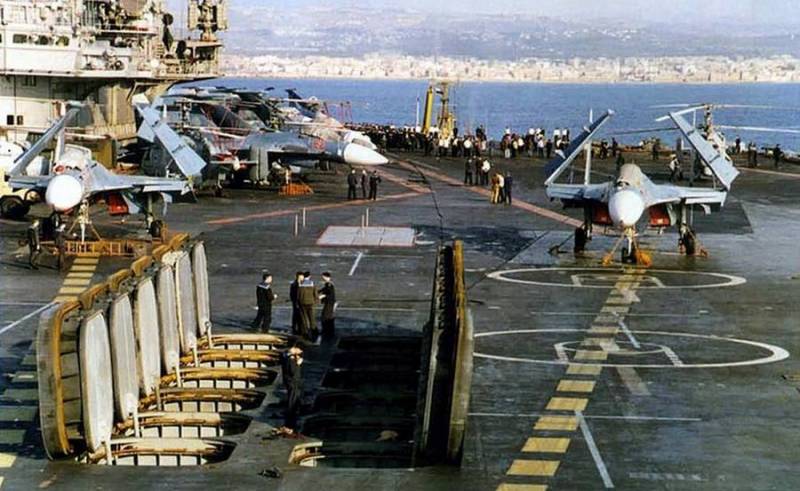
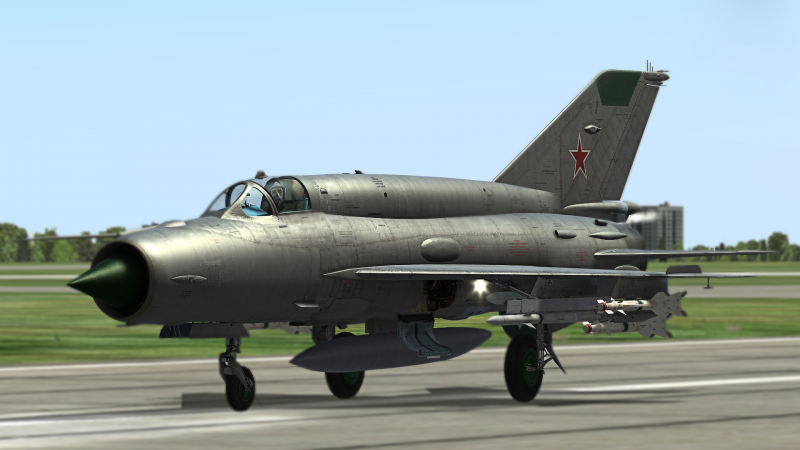
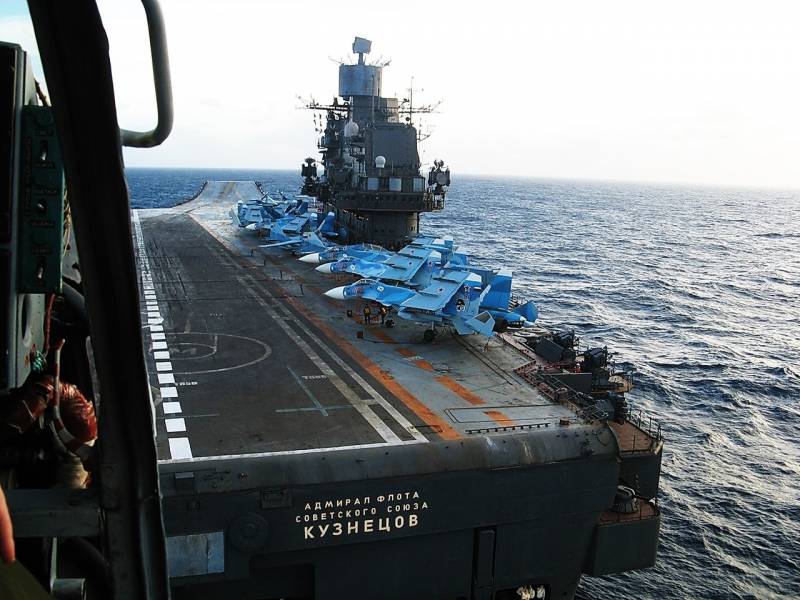
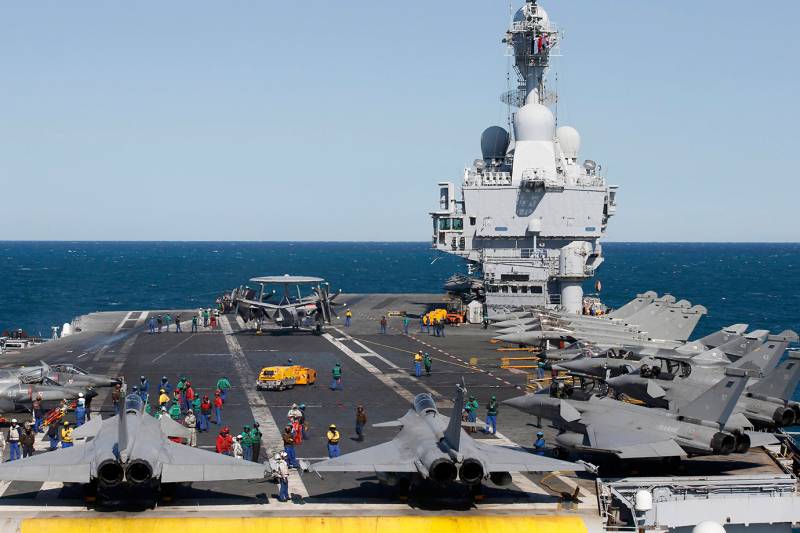
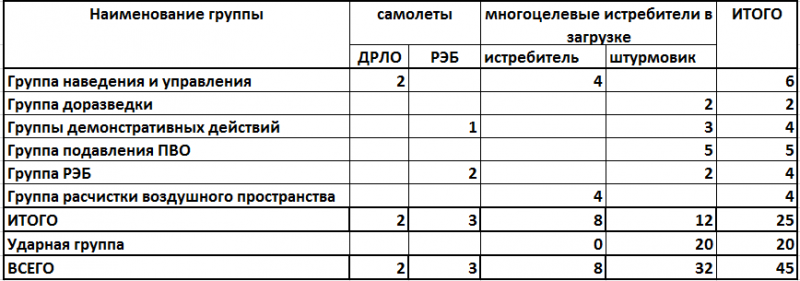
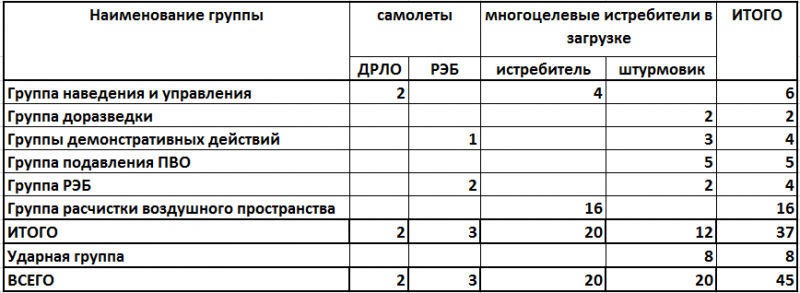
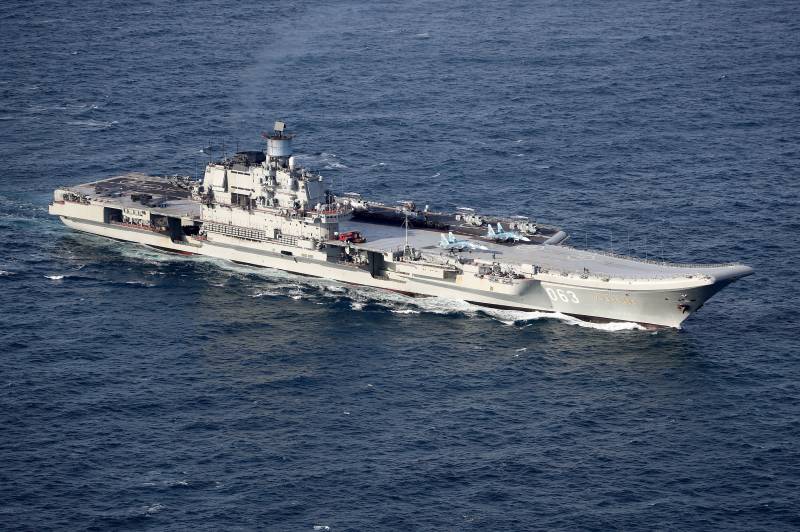
Information